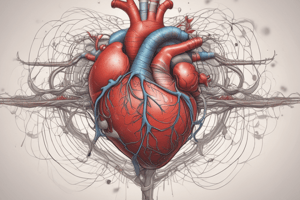Podcast
Questions and Answers
What type of blood vessel carries high-pressure blood from the heart to the body?
What type of blood vessel carries high-pressure blood from the heart to the body?
- Arteries (correct)
- Veins
- Lymphatic vessels
- Capillaries
During which phase of the cardiac cycle do the ventricles contract, pushing blood out into circulation?
During which phase of the cardiac cycle do the ventricles contract, pushing blood out into circulation?
- Diastole
- Systole (correct)
- Capillaries
- EKG
What is the primary function of veins in the circulatory system?
What is the primary function of veins in the circulatory system?
- Exchange between blood and cells
- Carry blood back to the heart (correct)
- Provide a constant supply of oxygen and nutrients to tissues
- Carry high-pressure blood from the heart
Which structural components are essential for understanding heart anatomy and physiology?
Which structural components are essential for understanding heart anatomy and physiology?
What is the purpose of an electrocardiogram (EKG) in heart health assessment?
What is the purpose of an electrocardiogram (EKG) in heart health assessment?
What are the two main components of the human cardiovascular system?
What are the two main components of the human cardiovascular system?
Which side of the heart receives deoxygenated blood from the body?
Which side of the heart receives deoxygenated blood from the body?
What type of blood do arteries carry away from the heart to the body's tissues and organs?
What type of blood do arteries carry away from the heart to the body's tissues and organs?
Which part of the heart is responsible for contracting rhythmically to push blood into the arteries?
Which part of the heart is responsible for contracting rhythmically to push blood into the arteries?
What is the function of capillaries in the blood circulation system?
What is the function of capillaries in the blood circulation system?
Study Notes
Cardiovascular System Overview
The human cardiovascular system is responsible for transporting nutrients, oxygen, hormones, and waste products between cells throughout the body. It consists of two main components: the heart, which acts as a pump, and the blood vessels, which carry blood from the heart to the rest of the body and back again. This complex network of structures works together seamlessly to ensure life-sustaining functions occur continuously within our bodies.
Anatomy of the Heart
The heart is a muscular organ that pumps blood through the circulatory system. It has four chambers: two upper chambers called atria and two lower chambers called ventricles. The right side of the heart receives deoxygenated blood from the body, while the left side receives oxygen-rich blood from the lungs. The walls of the heart's chambers are made up of specialized muscle tissue known as myocardium, which contracts rhythmically to push blood into the arteries that deliver it to various parts of the body.
Blood Circulation
Blood circulation refers to the continuous movement of blood through the body via the heart and blood vessels, which includes arteries, veins, and capillaries. Arteries carry oxygen-rich blood away from the heart to the body's tissues and organs, while veins return oxygen-depleted blood back to the heart. Capillaries, which connect arteries and veins, facilitate the exchange of gases, nutrients, and waste products between the blood and cells.
Types of Blood Vessels
There are three types of blood vessels: arteries, veins, and capillaries. Arteries have thick, elastic walls due to their role in carrying high-pressure blood from the heart to the body. Veins primarily carry blood back to the heart, with thinner walls that allow them to expand and contract under low pressure conditions. Capillaries are tiny and numerous, forming a vast network where the actual exchanges between blood and cells take place.
Heart Function
The heart performs several crucial functions, including providing a constant supply of oxygen and nutrient-rich blood to all bodily tissues and removing carbon dioxide and other waste products from these areas. It does this by alternating between filling and emptying its chambers during each heartbeat. A typical adult heart beats approximately 60 to 100 times per minute at rest, supplying roughly 25 quarts (23 liters) of blood to the entire body every time it completes one full contraction.
Electrocardiogram (EKG)
An electrocardiogram (EKG) is a noninvasive test used to record the electrical activity of the heart. It helps detect abnormal rhythms (arrhythmias), determine how well the heart's chambers are working, and evaluate whether the heart is receiving enough oxygen. An EKG can also reveal information about the overall functioning of the heart.
Cardiac Cycle
The cardiac cycle is the sequence of events that occurs when the heart pumps blood through the blood vessels. It involves the filling phase (diastole) followed by ventricular systole, the actual contraction of the heart chambers. During diastole, both atria fill with incoming blood before passing it to the ventricles; then, the ventricles contract simultaneously, pushing the blood out into the pulmonary and systemic circulation.
Heart Anatomy and Physiology
Understanding heart anatomy and physiology involves knowledge of the structural components, such as valves, muscles fibers, and conduction pathways, as well as the processes that control the flow of blood through the heart and the rest of the body. This understanding is essential for diagnosing and treating cardiovascular disorders effectively.
Studying That Suits You
Use AI to generate personalized quizzes and flashcards to suit your learning preferences.
Description
Test your knowledge about the human cardiovascular system, including the anatomy of the heart, blood circulation, types of blood vessels, heart function, electrocardiogram (EKG), cardiac cycle, and heart anatomy and physiology. Learn key concepts essential for understanding how the heart functions and circulates blood throughout the body.




